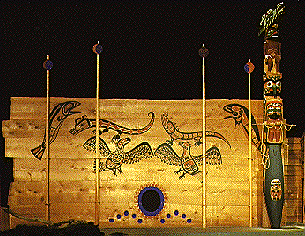Grand Hall tour
Nuu-Chah-Nulth House
Nuu-Chah-Nulth territory stretches from the northern part of western Vancouver Island south along the west coast to the western tip of the Olympic Peninsula in Washington State.
 Nuu-Chah-Nulth houses could be as long as 30 metres and were built with
cedar beams and hand-split boards according to the same principles as Coast
Salish houses. The Nuu-Chah-Nulth house in the Grand Hall represents a
house which belonged to the head chief of the Tsesha'ath people who live
near the present-day town of Port Alberni, at the head of Barkley Sound.
The house stood in the 1800s. Although Nuu-Chah-Nulth houses were often
set broadside to the beach, this house faced the beach.
Nuu-Chah-Nulth houses could be as long as 30 metres and were built with
cedar beams and hand-split boards according to the same principles as Coast
Salish houses. The Nuu-Chah-Nulth house in the Grand Hall represents a
house which belonged to the head chief of the Tsesha'ath people who live
near the present-day town of Port Alberni, at the head of Barkley Sound.
The house stood in the 1800s. Although Nuu-Chah-Nulth houses were often
set broadside to the beach, this house faced the beach.
Below its large round doorway are ten round holes, representing ten moons. Above the entrance, two Thunderbirds face each other, and above each Thunderbird is the figure of a Lightning Snake, the supernatural servant of the Thunderbird. Above the Lightning Snake are two supernatural Codfish, facing each other.
You may enter the house.
 The Nuu-Chah-Nulth Pole, a gift to the Canadian Museum
of Civilization from the Hesquiaht (Nuu-Chah-Nulth) people and the Royal
British Columbia Museum on the occasion of the opening of CMC's new
building, was carved by Tim Paul, with the assistance of Kevin Cranmer.
Art Thompson was commissioned to carve the headdress. The four main figures
are derived from the history of the Hesquiaht people:
The Nuu-Chah-Nulth Pole, a gift to the Canadian Museum
of Civilization from the Hesquiaht (Nuu-Chah-Nulth) people and the Royal
British Columbia Museum on the occasion of the opening of CMC's new
building, was carved by Tim Paul, with the assistance of Kevin Cranmer.
Art Thompson was commissioned to carve the headdress. The four main figures
are derived from the history of the Hesquiaht people:
- The top figure represents a founding ancestor of the Hesquiaht, a chief named Ma-tla-ho-ah; he is posed in a dancing position and wears an elaborate headdress combining a mythical serpent with the visage of the first whiteman to come in contact with the Hesquiaht people.
- The second figure represents a Thunderbird. Extending below each of the wings is a lightning serpent, the magical bolt the Thunderbird used to kill whales, which were its favorite prey.
- Placed between the Thunderbird's wings is the third significant figure. This is a mythic sea mammal hunter renowned for his ability to catch whales, sea otters and seals. He holds a whaling harpoon in his hands.
- The fourth figure represents the sea mammal hunter's rival, whom he placed inside a whale/canoe and sent out to sea in revenge for the murder of his sister.
The story told by the pole reinforces the belief that revenge must be taken against those who do wrong. Its main theme, however, is that humans who encounter supernatural beings and survive receive personal power.


